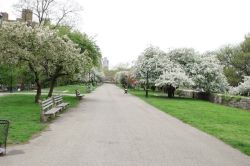Riverside Park
Warsaw Ghetto Memorial Plaza
Who is this memorial dedicated to?
This site is a solemn tribute to the Warsaw Ghetto Uprising and the six million Jews who were murdered by the Nazis and their fascist collaborators during World War II (1939-1945). The memorial honors those who kept the spirit of humanity alive through armed and unarmed collective resistance, and recognizes the courage and determination of their fight against tyranny and genocide. Begun on the eve of April 19, 1943, the Warsaw Ghetto Uprising was one of the earliest and largest episodes of Jewish armed resistance to the Holocaust (khurbn in Yiddish).
How was this created?
The original plaza was designed by Gilmore Clarke and Clinton Lloyd as part of the Riverside Park expansion completed in 1937 under the direction of then-Parks Commissioner Robert Moses.
On October 19, 1947, a cornerstone for an intended monument on this site was dedicated by members of the Jewish community, including newly arrived refugees and survivors of the khurbn, together with Mayor William O’Dwyer and other elected officials. Buried beneath the stone is a memorial scroll dedicated to the Jews of Europe, as well as two boxes containing soil from the Terezin and Sered concentration camps in Czechoslovakia.
Though several designs for a larger monument were considered beginning in 1948, there was no consensus. The survivor community – led by those affiliated with the Jewish Labor Bund – developed a tradition of gathering each April 19th at the stone, known in Yiddish as der shteyn. Together with the stone itself and the surrounding garden, these annual meetings of active remembrance have become the monument.
At the earliest gatherings at der shteyn, speakers included fighters and survivors of the ghettos, labor camps, death camps, and partisan groups. They witnessed unimaginable cruelty and suffering, as well as the resistance of their Jewish communities. Community members presented Yiddish poetry and songs written during and after the khurbn describing the conditions they endured and their hopes for liberation and a better future. As survivors dwindled, their descendants as well as scholars and community leaders have addressed the gatherings in both Yiddish and English, memorializing the courage of the khurbn generation. The annual ceremony concludes with everyone standing and singing in Yiddish the partisan hymn Zog Nit Keynmol (Never Say) followed by the Bundist anthem Di Shvue (The Oath), and laying flowers on der shteyn.
The perimeter gardens that surround der shteyn were designed and planted in 1990 by David T. Goldstick. In 2001 the Plaza was restored in partnership with the Riverside Park Conservancy with major support from the Deedy and David Goldstick Foundation and in-kind support from the International Masonry Institute of the Union of Bricklayers and Allied Craftsmen. Landscape architect Gail E. Wittwer-Laird designed the restoration, utilizing stone patterns and details indicated, but not implemented, in the original 1930s plan. Today, the landscaped plaza provides a dignified memorial and place for contemplation and learning within this historic park. It honors the memory of all who resisted, fought, died and survived.
Check out your park's Vital Signs
Clean & Safe
Green & Resilient
Empowered & Engaged Users
Share your feedback or learn more about how this park is part of a
Vital Park System

Know Before You Go
Due to construction, as of September 23, 2024, Cherry Walk at Riverside Park is temporarily closed between West 100th Street and St. Clair Place (West 125th St). Please view our Temporary Greenway Detour map for an alternative route.
Anticipated Completion: Spring 2025
Related inquiries may be sent to boatbasin@parks.nyc.gov
Related inquiries may be sent to boatbasin@parks.nyc.gov


